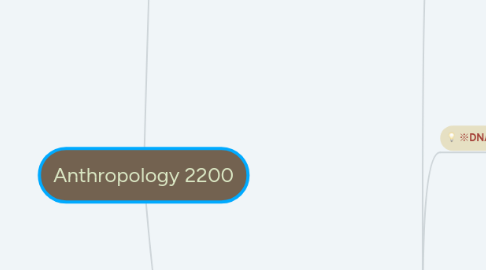
1. Introduction
1.1. What are humans?
1.1.1. A biocultural species
1.1.2. Tool makers
1.1.3. Abstract thinking
1.1.4. Communication
1.2. What is Anthropology?
1.2.1. A scientific study of humanity, concerned with human behavior, human biology, and societies, in both the present and past, including past human species.
1.3. Four Disciplines
1.3.1. Cultural
1.3.2. Archaeology
1.3.3. Linguistic
1.3.4. Biological/Physical
1.3.4.1. Human Biology
1.3.4.2. Primatology
1.3.4.3. Paleoanthropology
1.3.4.4. Skeletal Biology and Osteology
1.3.4.5. Bioarchaeology
1.3.4.6. Forensic anthropology
1.4. Ideal Forms
1.5. Humans in context
1.5.1. Human Biology
1.5.2. Culture
1.5.3. Physical Environment
1.6. History of Evolutionary thought
1.6.1. Evolution:
1.6.1.1. Biological change from generation to generation
1.6.2. Evolutionary Theory
1.6.2.1. Early thoughts on origins
1.6.2.2. Middle Ages
1.6.2.2.1. All creatures were static
1.6.2.3. Before Darwin
1.6.2.3.1. Speicies have changed
1.6.2.4. Darwin's Natural Selection
1.6.2.4.1. Variants help reproduction
1.6.2.5. Today
1.6.2.5.1. Evolution is the change in a population over time
2. Heredity and evolution
2.1. ※Gregor Mendal and his experiment
2.1.1. Laws of inheritance
2.1.2. Dominant&Recessive trait
2.1.2.1. Mendel's doctrine of genetics provided a new understanding of the evolution of species, and because of his contributions, people were able to discover the reasons why humans have evolved differently
2.1.3. Alleles
2.2. ※DNA
2.2.1. DNA sturcture
2.2.1.1. Sugar
2.2.1.2. Phosphate
2.2.1.3. Nucleotide base
2.2.1.3.1. A
2.2.1.3.2. T
2.2.1.3.3. C
2.2.1.3.4. G
2.2.2. Properties
2.2.2.1. Stability
2.2.2.1.1. Preseves genetic message
2.2.2.2. Replicability
2.2.2.2.1. Ensures inheritance
2.2.3. Genotype and Phenotypes
2.2.3.1. Genotype is the genetic makeup of an individual
2.2.3.2. Phenotypes are the ovservable or detectable physical characteristics of an organism
2.2.3.2.1. These two types are very important methods for studying the expression of genes
2.3. ※Evolutionary Forces
2.3.1. Mutation
2.3.1.1. DNA
2.3.1.1.1. Creating Genetic variation
2.3.2. Natural selection
2.3.2.1. Individual organism
2.3.2.1.1. Causes evolutionary change if genetic variation for traits that affect fitness
2.3.3. Sexual Selection
2.3.3.1. Chromosomes&sexual reproduction
2.3.3.1.1. A Speical Case of Natural Selection
2.3.4. Gene flow
2.3.4.1. Population
2.3.4.1.1. transfer of genetic material from one population to another
2.3.5. Genetic drift
2.3.5.1. Population
2.3.5.1.1. A mechanism of evolution in which allele frequencies of a population change over generations due to chance
2.3.6. Nonrandom mating
2.3.6.1. Lineages
2.4. Evolution in humans
2.4.1. Variation
2.4.1.1. Genetic variation
2.4.1.1.1. Adaptation
2.4.1.2. Phenotypic variation
2.4.1.2.1. Adaptation
2.4.2. Race
2.4.2.1. Concept
2.4.2.1.1. Race is not biological
2.4.2.1.2. History
2.4.2.2. Skin color
2.4.2.2.1. Environmental influence(Pigment)
2.5. Lab 2
2.5.1. I separated the lab2 section because I really liked this one. This lab gave me new insights into genetics. I was under the impression that sickle cell genes were often useless and very harmful, and that such genes should disappear gradually. But this lab experiment showed me that there is no perfect gene, only the most suitable gene for the environment. Even a defective sickle cell gene can survive and have some unexpected effects under certain circumstances. For me, this is a very shocking knowledge.

